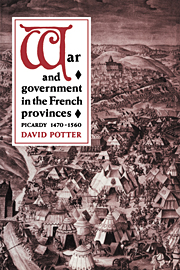Book contents
- Frontmatter
- Contents
- Acknowledgements
- List of abbreviations
- Notes on transcriptions of documents, units of money and measures
- Introduction
- 1 Return to allegiance: Picardy and the Franco-Burgundian Wars, 1470–93
- 2 The provincial governors and politics
- 3 The governors' staff and household
- 4 The Picard nobility and royal service
- 5 Military organisation in Picardy during the Habsburg–Valois wars
- 6 ‘Les fruictz que la guerre rapporte’: the effects of war on the Picard countryside, 1521–60
- 7 War, taxation and the towns
- 8 Peace negotiations and the formation of the frontier in Picardy, 1521–60
- Conclusion
- Appendices
- Bibliography
- Index
8 - Peace negotiations and the formation of the frontier in Picardy, 1521–60
Published online by Cambridge University Press: 06 October 2009
- Frontmatter
- Contents
- Acknowledgements
- List of abbreviations
- Notes on transcriptions of documents, units of money and measures
- Introduction
- 1 Return to allegiance: Picardy and the Franco-Burgundian Wars, 1470–93
- 2 The provincial governors and politics
- 3 The governors' staff and household
- 4 The Picard nobility and royal service
- 5 Military organisation in Picardy during the Habsburg–Valois wars
- 6 ‘Les fruictz que la guerre rapporte’: the effects of war on the Picard countryside, 1521–60
- 7 War, taxation and the towns
- 8 Peace negotiations and the formation of the frontier in Picardy, 1521–60
- Conclusion
- Appendices
- Bibliography
- Index
Summary
On 3 April 1559, the long intermittent war which had begun in 1521 was finally terminated by the treaty signed at Le Cateau-en-Cambrésis. The significance of this peace has long been understood, somewhat simplistically, as a sort of ‘hinge’ between the Habsburg–Valois Wars and the epoch of the Wars of Religion. The details of the negotiations are well known, though the classic work of de Ruble largely ignores the problems of implementation insofar as they concern the north. On the surface, of course, there was no reason to suppose that the treaty would be any more durable than its predecessors; it had been the exhaustion of the great monarchies that had motivated a substantial effort at settlement and the continuation of that exhaustion, coupled with the descent of France into civil war after 1562, froze the agreements that were reached in 1559. It is also easy to forget that the political imperatives behind war dictated that fighting should be accompanied by frequent, even longlasting, negotiations for the conditions which would be conducive to ‘une bonne paix’, or stable settlement. What this meant for both sides, of course, was distinctly divergent, but both sides faced similar problems: how to achieve a stable relationship. This in turn meant agreement on the conflicting territorial and jurisdictional claims of the Valois and Habsburg monarchies, including Navarre, Savoy-Piedmont, French claims in Italy and, of course, the frontier between France and the Low Countries.
- Type
- Chapter
- Information
- War and Government in the French Provinces , pp. 265 - 293Publisher: Cambridge University PressPrint publication year: 1993



